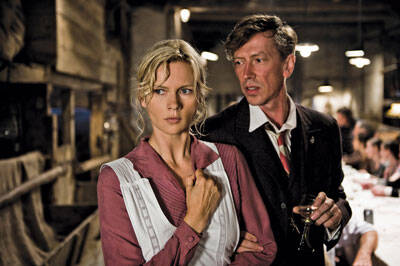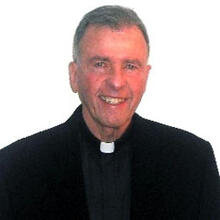Another Holocaust movie. Haven’t filmmakers exhausted this topic? The question reveals a trivialization of two profound mysteries: the mystery of evil and the mystery of artistic creativity.
To think that the evil made manifest in the horrors of the Holocaust could be depicted in some ultimate way so that future depictions would be superfluous is to minimize the mystery of evil, which is like an unfathomable abyss. It is also to forget that when gifted artists use their skills to create, even when they focus on something dealt with previously by others, new meanings and insights may result.
The French film director Jean-Luc Godard once said that every camera angle involves a moral decision. Many moral and artistic choices are made in filmmaking; anyone working on a film—producers, writers, directors, cinematographers, actors—can en-hance or weaken the work. I cannot report one misstep in the marvelous film Saviors in the Night, which has just been released in the United States.
A true story, this film is based on the memoirs of Marga Spiegel, which tell how she, her husband, Menne, and their daughter, Karin, were saved from extermination in the death camps. Courageous farmers in the region of Munsterland hid them for 30 months.
Some of these farmers were members of the Nazi party; and at least one couple, Heinrich and Maria Aschoff, had a daughter, Anni, in the Hitler Youth movement and a son, Klemens, fighting in Hitler’s war. The “saviors” had been subject to the propaganda concerning Jews that Hitler and his cohorts promoted, but through a miracle of grace their consciences fought the lies and bigotry. Early in the film Anni, having been indoctrinated through the Hitler Youth movement, is angry when she first learns that her parents are hiding Jews. One of her parents delivers a line that sums up much of the film: “We are Germans, but we are also Catholics.” “Saviors in the Night” dramatizes the conversion experience of some Catholics, who come to understand more profoundly and live with greater commitment their own faith.
Marga and Karin did not fit the stereotypical image of Jews, so they were able to “pass” as Germans who had come to the Aschoff farm to avoid the bombing in the cities. Menne, who looked less German, had to hide for two and a half years in a meat-smoking locker.
In the first moments of the film, the gross injustice toward the Jews is emphasized. The film opens in 1918, toward the end of the First World War, and Menne is awarded the Iron Cross for heroism in fighting for his country. A quick cut and 25 years later, Menne’s Iron Cross has been replaced by a yellow star. He has gone from hero to fugitive. The rest of the film dramatizes how the Aschoffs, their relatives and friends save the Spiegels from extermination.
Part of the film’s brilliance is the way it captures the terror of the Holocaust without ever taking us to the concentration camps. We see, or rather experience, the evil of the camps through the family’s constant fear that they will be discovered. But the Jews are not the only ones who are afraid.
The “saviors” know that if they are caught concealing Jews, they will be killed immediately. While reflecting on the constant danger these farmers freely accepted, I have often asked myself: What would I do in that situation? That the question keeps recurring suggests the power of the film.
“Saviors in the Night” eschews physical violence and focuses instead on the human drama involved in choosing good or evil, the drama of sin and salvation. On one level the film is an adventure story about the hunted and the hunter; on another it is about adventures in grace. The film director Ingmar Bergman thought a camera could film a soul. “Saviors in the Night” films consciences.
In a lovely scene Maria, taking a bath in a large round wooden tub, invites Marga to join her. The two women giggle like young girls while they share the tub. As Maria scrubbed Marga’s shoulders and arms, I sensed that not only was the bathing physically refreshing but that something else was happening—Maria was washing away the past wrongs inflicted on Marga because of her Jewishness.
Ludi Boeken, the director, keeps us in the center of the drama by using close-ups and camera shots that confine us within the same area as the Jews and farmers. His cinematic techniques never distract but rather keep us physically, emotionally, morally and spiritually tied to the characters. Boeken explained, “I have tried to portray the people, the events, the tensions and the moments of relief in all simplicity, without over-dramatization—as if we happened to be there and witnessed some of what occurred….”
That is precisely what he has done. By not over-dramatizing he leads us deeply into the drama and, in a mysterious way that is part of the magic of film, places us at its center. Part of Boeken’s successful handling of the story may be due to his own history. How could he, a Jew, make a film in which Germans, some of them Nazis, were heroes during the Holocaust? The reason is that his own parents had been saved in Holland by people like the German farmers in “Saviors.”
Indirectly, the film suggests that many more Jews could have been saved had there been more people of courage. The Talmud says, “He who saves a single life saves the world entire.” Whenever conscience is challenged, the material for drama is present.
That “Saviors in the Night” is a true story adds to its power. Marga Spiegel, now 97, for years gave talks telling her story. In an addendum at the end of the film, Marga and Anni, now the closest of friends, are shown on the set with some of the actors and crew. A postscript, a device that does not always work in films, underlines the realism of this movie: the events depicted actually happened, and the actors portray real people who resisted the evil that engulfed many.
Another Holocaust film? Yes, and a great one.









The Talmud only praises the saving of Jewish lives!
James Phillips